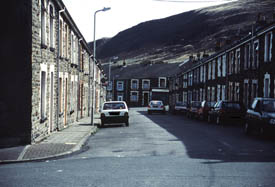Historic Landscape
Characterisation
The Rhondda
021 Maerdy
HLCA 021 Maerdy
Second phase pithead colliery settlement; valley-head location; single
colliery specific; planned nucleated settlement; second phase core of
uniform homogeneous terraced housing, colliery-built housing and leisure
facilities; strongly residential and relatively low commercial development,
with 3rd phase additions including extensive ribbon development; distinct
separate identity from neighbouring community; reclaimed industrial landscape.
Click here for character
area map
(Back to map)
The historic landscape area of Maerdy encompasses the colliery settlement and former colliery site of Mardy. This settlement primarily lies on the farm of the same name and that of the neighbouring farm of Rhondda Fechan. The name Maerdy (also Mardy) is indicative of the site's medieval origin, and records the location of a steward's house or settlement; an important aspect of the site during the medieval period would have been its administrative function, controlling access to, and use of, the surrounding common. By the late 19th century all trace of the farm had been removed by the developing pithead settlement (2nd edition 6-inch OS map, 1900 (revised 1897-98).
The industrial settlement of Maerdy developed typically following the establishment of its industrial base, namely its colliery; thus the first edition OS map of 1884, (surveyed 1875) only shows a single tramway between Maerdy Farm and a coal shaft (the site of the Mardy Colliery). This was Mardy Nos. 1 and 2 Pits sunk in 1875 by the partnership of Mordecai Jones and Wheatley Cobb. These pits were deepened in 1878 to reach the steam coal; the following year the colliery was sold to the Lockett-Merthyr Company, under whose management the company prospered. In 1885 this colliery was the site of a tragic gas explosion, which resulted in the death of some 81 miners. The workings were extended in 1893 with the sinking of Mardy No. 3 Pit approximately a mile further up the valley, and again in 1914 with the sinking of No. 4 Pit close-by. By the publication of the second edition 6-inch OS map (published 1900, revised 1897-98) the core of the pithead settlement at Maerdy, a nucleated grid pattern layout within a compound enclosed by a perimeter wall, is in place. The settlement at this time consists of James Street, Griffith Street, Wood Street, Mountain Road, North Terrace, Oxford Street, Pentre Road and Church Street. By this date the settlement had a church, infant school, and recreation ground, while an extension south of the main core along Maerdy Road includes an additional school, the Royal Hotel, and two chapels, Capel Bethania and Capel Seion. Also shown are the terminal Station of the Taff Vale Railway, the mineral railway to the Mardy Colliery's No. 3 Pit and the reservoir at Castell Nos. By the publication of the 1921 edition 6-inch OS map, the core of the settlement is complete, with the addition of Edward Street and allotments within the compound (1921 edition 6-inch OS map, revised 1914). Of the period is the impressive Workman's Institute by Edmund Williams (1882-1905). Further expansion southeast of Maerdy Road has also occurred including the creation of Richard's Street and Blake Street and provision of a football ground.
Once the core area of the settlement had been completed geographical constraints ensured a linear settlement expansion. The result being a ribbon accretion running south to Ferndale Cemetery, and the northern limits of the adjacent settlement. Later infilling at the edge of the settlement typically includes larger higher status housing, typically with bay windows, and the ubiquitous local petrol station and industrial estate. The commercial status of the settlement, which has a post office and a few shops selling necessities chiefly along Maerdy Road, is essentially low.
The reclaimed industrial landscape to the north of the settlement is the extensive site of Mardy Colliery. Mardy No. 1 and No. 2 Pits were closed in 1932 under Bwllfa and Cwmaman Collieries Ltd and in 1940, five years after being taken over by the Powell Dyffryn Company, Cardiff Nos. 3 and 4 Pits ceased production. Following nationalisation in 1947, a modern colliery was constructed on the site of Nos. 3 and 4 Pits, with underground workings linked to Bwllfa. This was the result of a £5 million modernization scheme for working the coal reserves of both the Cwmdare and Rhondda Fach valleys, given approval in 1948. The colliery, the last remaining working pit in the Rhondda, was finally closed on 21 December 1990, and in March 1996 the site was cleared to make way for an industrial unit (the Fenner Polymer factory).
